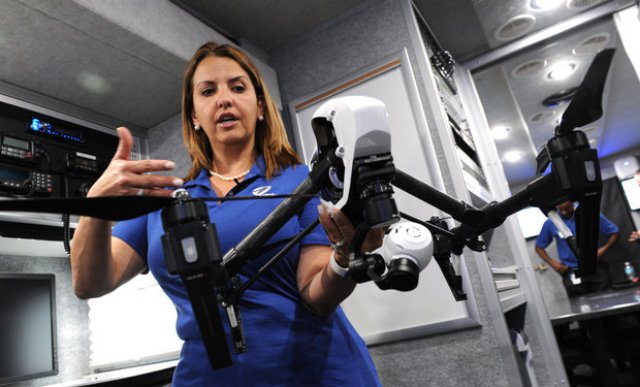 Florida Power & Light Co. joined the ranks of private companies looking into how drone technology could improve their services this year. Iliana Rentz, FPL’s emergency preparation program manager, holds a Small Unmanned Aerial System.
Florida Power & Light Co. joined the ranks of private companies looking into how drone technology could improve their services this year. Iliana Rentz, FPL’s emergency preparation program manager, holds a Small Unmanned Aerial System.
It’s a drone they hope the company will be able to use for damage surveillance after storms or hurricanes. Currently, FPL has to use ground crews or helicopters for the same job, which is more costly than using a $3,000 drone.
“So the purpose of the device would be to actually reach those hard-hit areas, those areas that otherwise would be very difficult, costly and cumbersome to get to immediately following a storm,” Rentz said. “You’re able to make it airborne, over the lines and see how extensive the damage is, and perhaps even, if the damage isn’t that extensive, perform minor restoration effort and restore power to our customers much sooner.”
That technology is in its beginning stages, since the battery power on the sUAS only lasts 15 minutes and government laws on drone usage are strict and require extensive licensing. But Rentz said she thinks it’s reasonable to expect the technology within a few years.
This year, FPL unveiled the damage assessment application, a system to allow crews to enter and survey damage so a command center can see it in real time and dispatch crews accordingly.
Before 2015, crews would have to go out to damaged areas, write down observations on a ticket and take it back to a command center, where it would be processed before crews could be sent out, adding hours to response times.
“Nowadays, as I capture information, an area manager or incident commander is in the office looking at that information that’s being collected, and they can immediately see the extent of the damage, pockets of heavy damage and the type of damage that we’ve experienced,” Rentz said. “That will allow us to better assign the resources to the right work at the right time.”
Other technologies FPL has had for a few years now include a smart grid system, which allows crews to make sure power is actually working in nearby homes after they make repairs. Back at command centers, people can use the systems to check the status of every individual line and track crews with GPS systems.
“When a crew restores a transformer, in the past they would leave the area not necessarily knowing that I was out of power,” Rentz said. “Now, using an iPad, they can ping that smart meter before they leave the neighborhood, to make sure that every customer served by that transformer has their power restored.”
The command centers can also go mobile now, going into heavily damaged areas to ease communication with their crews and quicken response times. The mobile command center unveiled Tuesday afternoon has its own cellular signals, two for voice and two for data, and power supplied by an onboard generator that can last up to 80 hours.
“We would generally deploy these in the hardest hit areas,” said Shane Forrester, emergency preparedness specialist for FPL.
FPL has also been using concrete poles to reinforce power lines, rather than just wood. That makes the lines less susceptible to serious damage, which means power outages don’t last as long.
All of that combined means people will have to spend less time in the dark and without power during major storms or hurricanes, Rentz said. Even from just a few years ago, Rentz said outage times have significantly decreased.
“Ultimately, what this does is bring customers up and provide power back to our customers to restore normalcy quicker, safely and more efficiently than ever before.”
Source: Bradenton Herald
